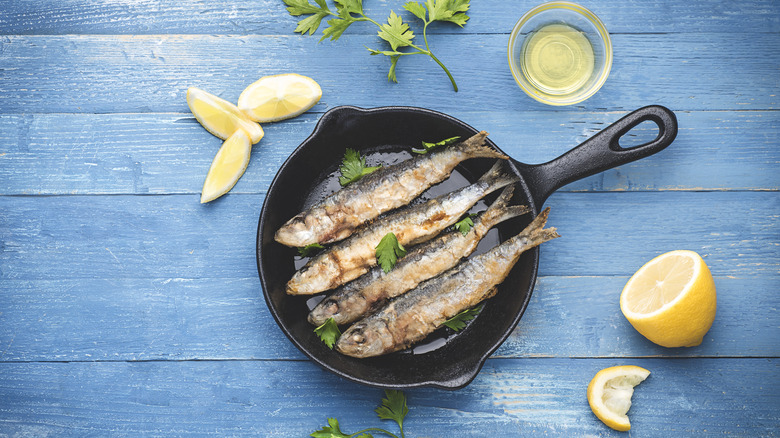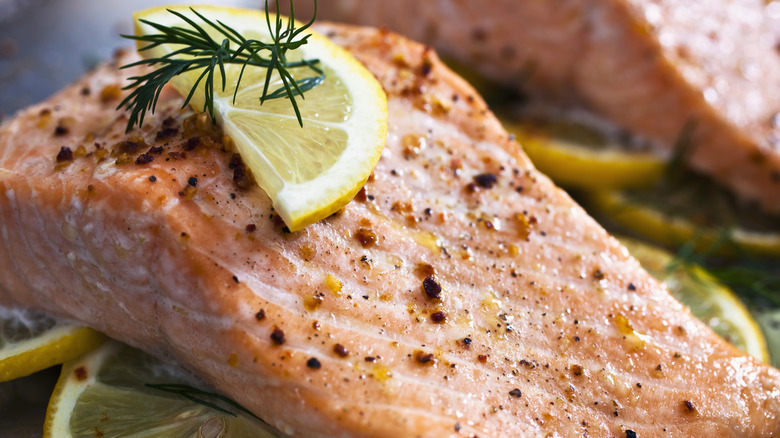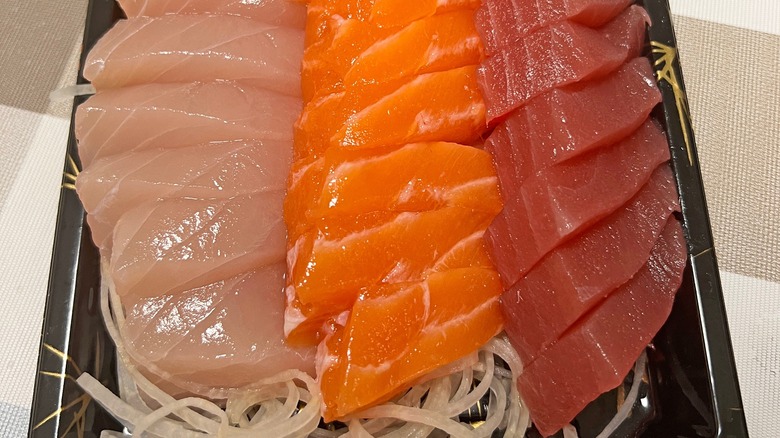The Common Fish With The Lowest Mercury Levels
At this point, it's well known that every fish contains at least a tiny amount of toxic mercury, or methylmercury to be specific. Even though mercury can be produced naturally, the high mercury levels in fish are a modern problem resulting from man-made pollution. Industrial activities like mining and coal-burning power plants release mercury, which ends up in our oceans. Once it's in the water, it can get converted into methylmercury, which is significantly more dangerous to us. However, mercury levels aren't spread evenly among fish, and there are certain species that are considered safer to eat because they've got less of this toxic compound swimming through their blood.
According to the U.S. Food and Drug Administration (FDA), shellfish such as scallops, clams, and shrimp have the lowest mercury levels. Following that, lots of canned fish are also fairly low — these include sardines, anchovies, and salmon. When it comes to fish like salmon, which are popular both canned and fresh, there is noticeably more mercury in the fresh version than the canned version. Some other low-mercury fish include tilapia, catfish, squid, and pollock.
How some fish avoid (too much) mercury
As a general rule, small, short-lived, and non-predatory fish that are low on the undersea food chain have the lowest amounts of mercury. Smaller fish like sardines aren't big enough to eat much more than plankton, and fish like the popular tilapia eat lots of algae, for example. Predatory fish with longer lifespans, such as tuna, have greater mercury levels because they eat lots of small fish with small amounts of mercury, which then accumulates in the larger, longer-lived fish. In short, the higher up the food chain you go, the more mercury you're consuming. Tuna live for about 15 years, so mercury builds up over time in their tissues; sardines only live around five years.
But what explains that discrepancy between canned and fresh fish? Usually, smaller varieties of fish are used in canned food. Fish like salmon have several subspecies: pink salmon is a common choice for canned salmon, and they're tiny fish that only weigh about 4 pounds on average. Unsurprisingly, pink salmon eat a lot of zooplankton. Meanwhile, larger Atlantic salmon are commonly sold fresh and they're around 10 pounds, and their greater size means they can eat other fish and crustaceans, which are more mercury-heavy meals.
The most mercury-laden sea creatures
When you take a look at the fish with the highest mercury levels, you'll find that the ocean's greatest predators and connoisseurs of their fellow fish are at the top of the list. Sharks, swordfish, certain tilefish, and king mackerel have the greatest amounts of mercury in them, and the FDA explicitly advises against eating these species because of this. Tilefish are a special case because they vary by region: tilefish caught in the Gulf of Mexico have outrageously high mercury levels, while other Atlantic tilefish are considered relatively safe, containing less than one-eighth the amount of mercury, according to the FDA's data.
Is there a serious risk of getting mercury poisoning from canned tuna or panned-fried fish fillets? When consumed in moderation, most fish, except for those aforementioned top-of-the-chain species, are safe to eat. Pregnant women, breastfeeding mothers, and young children are at the greatest risk of harm, and mercury poisoning can cause birth defects in newborns. However, the FDA actually advises pregnant and breastfeeding mothers to consume seafood and states that most fish (roughly 90%) commonly eaten in the U.S. are deemed safe so long as you only eat about two or three servings per week. Fish are highly nutritious and a good source of omega-3 fatty acids, so there's no need to cut them out of your diet completely.


